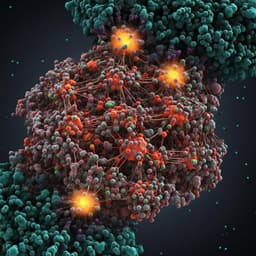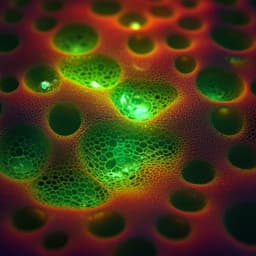
Chemistry
PEG-stabilized coaxial stacking of two-dimensional covalent organic frameworks for enhanced photocatalytic hydrogen evolution
T. Zhou, L. Wang, et al.
This study unveils a novel strategy to stabilize the ordered structure of two-dimensional covalent organic frameworks, which are key materials for photocatalytic hydrogen evolution. By incorporating polyethylene glycol in the mesopore channels, the researchers enhance charge transport and significantly boost hydrogen production under visible light, promising advancements in energy solutions. This groundbreaking research was conducted by Ting Zhou, Lei Wang, Xingye Huang, Junjuda Unruangsri, Hualei Zhang, Rong Wang, Qingliang Song, Qingyuan Yang, Weihua Li, Changchun Wang, Kaito Takahashi, Hangxun Xu, and Jia Guo.
~3 min • Beginner • English
Introduction
The study addresses the instability of layered π-stacking in two-dimensional covalent organic frameworks (2D COFs) during photocatalytic cycling in water. While conjugated polymers and COFs can be engineered to absorb visible light and facilitate charge separation and transport, many polymeric photocatalysts are amorphous or semicrystalline, limiting intermolecular charge transfer. 2D COFs, with extended π-conjugation and layered structures, offer improved exciton delocalization and charge mobility. Prior work focused on chemically stable linkages (β-ketoenamine, sp2 C=C, triazine) and electron-donating/withdrawing groups to tune band structure and redox behavior. However, the effect of layered stacking order on H2 evolution has been underexplored, and XRD attenuation after photocatalysis suggests stacking disorder or amorphization that shortens conjugation length and degrades activity. The hypothesis is that preserving ordered layered π-stacking in 2D COFs will enhance photocatalytic hydrogen evolution by facilitating charge transport and reducing structural distortion under operating conditions.
Literature Review
The paper reviews advances in polymeric and COF-based photocatalysts for hydrogen evolution, noting that many are amorphous or semicrystalline, which hampers charge transfer. Chemically stable COF linkages such as β-ketoenamine, sp2 carbon-conjugated frameworks, and triazine-based frameworks have improved stability and photophysics. Incorporation of donor/acceptor units (diacetylene, hydrazone, azine, sulfone) has been used to tune redox potentials and enhance charge separation. Nonetheless, several studies reported significant attenuation of 2D COF XRD signals post-photocatalysis, indicating impaired stacking or amorphization, which can twist backbones and reduce π-conjugation length, negatively affecting activity. The authors identify a gap: strategies to preserve and stabilize layered π-stacking in 2D COFs during photocatalysis are scarce, despite its importance for exciton delocalization and charge transport.
Methodology
Synthesis of BT-COF: The benzothiadiazole-containing β-ketoenamine-linked COF (BT-COF) was synthesized via aldimine condensation of 1,3,5-triformylphloroglucinol (Tp) and 4,4′-(benzo-2,1,3-thiadiazole-4,7-diyl)dianiline (BT) in o-dichlorobenzene/n-butanol (19/1, 1 mL) using pyrrolidine (0.1 mL) as catalyst at 120 °C for 3 days. Product was washed by Soxhlet extraction (THF, 3 days) and dried under vacuum to yield 63% of deep-red powder. A HOAc-catalyzed analogue (BT-COF(HOAc)) and an amorphous poly(TpBT) (reflux in 1,2-dichlorobenzene) were also prepared for comparison.
Characterization: FT-IR identified β-ketoenamine bands (C=O 1620 cm−1, C=C 1451 cm−1, C–N 1255 cm−1). 13C CP/MAS NMR showed carbonyl (185–187 ppm), –NH–C (147 ppm), aromatic carbons (114–138 ppm), BT carbon (153 ppm), and aliphatic signal (~25 ppm from terminal groups). Elemental mapping (EDS) confirmed uniform C/N/O/S distribution. HRTEM showed periodic structures. PXRD revealed high crystallinity with peaks at 2.71°, 4.70°, 5.40°, 7.29°, and 26.15° assigned to (100), (110), (200), (210), (001). Pawley refinement (P6) gave a = b = 38.043 Å, c = 3.4685 Å. N2 sorption at 77 K: type IV isotherm, BET area 1471 m² g−1, pore volume 1.29 cm³ g−1, pore size ~2.4 nm. Stability tests included immersion in THF, DMF, 12 M HCl, and 1 M NaOH for 3 days with PXRD monitoring.
PEG infiltration (PEG@BT-COF): Activated COF was suspended in acetonitrile; PEG (Mw = 20 kDa) acetonitrile solution added, then evacuated to ~0.3 kPa and thermally annealed at 100 °C for 12 h to drive infiltration into 1D mesopores. PEG loading varied (10–40 wt%). Evidence of confinement was obtained by DSC (disappearance of PEG melting at ~64 °C for 30 wt% loading; reappearance at 40 wt% indicating excess PEG outside pores), TGA (weight losses matched target loadings), 13C CP/MAS NMR (PEG signal at 71 ppm), N2 sorption (BET drop to 223, 132, 35 m² g−1 for 10, 20, 30 wt% PEG), WAXS (retained (100), (110), (200), (210) peaks), and THF extraction restoring BT-COF crystallinity and BET (~1286 m² g−1). 2D 1H–13C HETCOR NMR showed strong cross-peaks between PEG carbons and BT-COF aromatics for infiltrated samples, absent in simple physical mixtures, indicating sub-nanometer proximity inside pores. Crystallite sizes were estimated using Scherrer analysis of WAXS (100) peaks.
Computations: TDDFT (CAM-B3LYP) simulated UV spectra and excited-state geometries on cut-out models (G1–G3) and stacked dimer (D1). DFT computed ground- and excited-state IP/EA values; solvation model density used for aqueous effects. Interactions with water and diethyl ether (PEG surrogate) were assessed. DPD simulations modeled PEG-20k conformation in cylindrical pores with hydrogen bonding to pore walls.
Photocatalytic hydrogen evolution: Reactions used 10 mg catalyst loaded with photodeposited Pt (typically 5 wt% nominal; ICP ~3.5–3.7 wt%), in 100 mL water with 0.1 M ascorbic acid (AA), argon-purged, illuminated by 300 W Xe lamp with >420 nm cutoff at 100 mW cm−2, temperature maintained at 10 °C. H2 quantified by GC-TCD. Variables studied included pH (1.6–5.6), Pt loading (without Pt to 7 wt%), PEG loading (10–30 wt%) and molecular weight (Mn 400, 2000, 20k). Apparent quantum efficiencies (AQE) measured at selected wavelengths (420–650 nm). Long-term cycling up to 48 h assessed with crystallinity and surface area characterization before/after; photocurrent, EIS, and TCSPC measured on recycled samples.
Key Findings
- Structure and porosity: BT-COF exhibits high crystallinity with AA stacking; refined unit cell a = b = 38.043 Å, c = 3.4685 Å; (001) interlayer distance ~3.5 Å. BET surface area 1471 m² g−1, pore volume 1.29 cm³ g−1, pore size ~2.4 nm.
- PEG confinement: DSC shows disappearance of PEG melting for 30 wt% loading, indicating confinement; reappears weakly at 40 wt% (excess outside pores). BET area decreases to 35 m² g−1 at 30 wt% PEG; WAXS confirms retained in-plane order; THF extraction restores BT-COF crystallinity and BET (~1286 m² g−1). 2D 1H–13C HETCOR NMR shows close PEG–COF contacts in infiltrated samples but not in physical mixtures. Crystallite size retains 86.1% (44.6 → 38.4 nm) upon PEG loading.
- Electronic structure: UV–vis onsets: TP-COF 532 nm, poly(TpBT) 574 nm, BT-COF(HOAc) 579 nm, BT-COF 593 nm, 30%PEG@BT-COF 599 nm. Optical bandgaps: BT-COF 2.09 eV; 30%PEG@BT-COF 2.07 eV. Valence bands at −5.10 eV (both); conduction bands ~−3.01 to −3.03 eV. DFT redox potentials show suitable driving force for proton reduction using AA as sacrificial donor; interaction with water or PEG surrogate alters potentials by <0.1 V.
- Photocatalytic performance (visible light >420 nm, 0.1 M AA, ~3.5 wt% Pt, 10 mg catalyst, 100 mL water): HERs: TP-COF 1.45 mmol g−1 h−1; BT-COF 7.70; 30%PEG@BT-COF 11.14; poly(TpBT) 0.8; BT-COF(HOAc) 2.02. Increasing PEG (20k) loading from 10 to 30 wt% increases HER from 8.90 to 11.14 mmol g−1 h−1. Without Pt: 0.25 mmol g−1 h−1. Optimal pH ~3.6 (8.44 mmol g−1 h−1). Pt loading optimum around 7 wt% nominal (HER 7.95 mmol g−1 h−1), with similar activity at 5–7 wt%.
- AQE: For 30%PEG@BT-COF: 11.2% (420 nm), 9.9% (500 nm), 8.9% (550 nm), 2.9% (600 nm), 1.1% (650 nm), approximately 1.5× higher than BT-COF at each wavelength; 11.2% at 420 nm ranks among top COF photocatalysts.
- Stability and photophysics: Over 48 h visible irradiation, 30%PEG@BT-COF shows only 8% decline in 8-h cycle HER versus 21% for BT-COF. Recycled 30%PEG@BT-COF retains crystallite size at 86.2% of initial (38.4 → 33.1 nm), whereas BT-COF retains 48.4% (to 21.6 nm). Recycled 30%PEG@BT-COF exhibits higher transient photocurrent, lower charge-transfer resistance (EIS), and longer average exciton lifetime (25.5 ns) than recycled BT-COF (17.6 ns). After long-term cycling, only ~5.9 wt% PEG loss from 30%PEG@BT-COF.
- Generality: PEG stuffing also boosts TP-COF performance (1.45 → 2.82 mmol g−1 h−1). Short-chain PEGs (Mn 400, 2000) leach out during tests and do not confer stability/performance benefits.
- Pt nanoparticles: Uniform deposition; average sizes ~1.9 nm on BT-COF and ~2.3 nm on 30%PEG@BT-COF; size differences not decisive for activity improvement.
Discussion
The findings support the hypothesis that maintaining ordered layered π-stacking in 2D COFs enhances photocatalytic hydrogen evolution. Pristine BT-COF offers favorable band structure and high crystallinity, but its layered order degrades during photocatalysis, especially during Pt photodeposition, leading to reduced activity. Infiltrating high-molecular-weight PEG into mesopores anchors elongated polymer coils to pore walls via hydrogen bonding, mechanically constraining layers and suppressing interlayer gliding. This preserves coaxial stacking and π-orbital alignment, leading to prolonged exciton lifetimes, higher photocurrent, and reduced charge-transfer resistance in recycled catalysts. PEG does not significantly alter COF electronic structure, indicating the performance gains stem from structural stabilization and improved charge transport rather than band-edge shifts. The approach is generalizable, as shown by improved performance in TP-COF. Overall, PEG stuffing mitigates structural amorphization under aqueous photocatalytic conditions, enabling higher HER, higher AQE, and better long-term stability.
Conclusion
This work introduces a practical post-engineering strategy to stabilize the layered stacking of 2D COFs by stuffing high-molecular-weight PEG chains into mesoporous channels. In a β-ketoenamine-linked, benzothiadiazole-containing COF (BT-COF), PEG confinement preserves AA-stacking during photocatalysis, maintains π-conjugation and charge-transport pathways, and markedly enhances performance: HER increases from 7.70 to 11.14 mmol g−1 h−1 with an AQE up to 11.2% at 420 nm, alongside improved stability over extended irradiation. Electronic structure remains essentially unchanged by PEG, confirming a mechanical/structural stabilization mechanism. The strategy is applicable to other COFs (e.g., TP-COF). Future work could integrate this stabilization approach into more complex architectures such as donor–acceptor heterojunctions and Z-scheme systems on COF platforms, explore other polymer guests or interactions to optimize stacking stabilization, and assess scalability and durability under practical solar-driven conditions without sacrificial donors.
Limitations
- The photocatalytic tests rely on ascorbic acid as a sacrificial electron donor under mildly acidic conditions (optimal pH ~3.6); performance and stability under pure water splitting or alternative donors were not demonstrated.
- In basic aqueous media (e.g., 1 M NaOH), crystallinity decreases, indicating limited robustness across pH extremes.
- Although PEG stabilizes stacking, some polymer leaching (~5.9 wt% over long-term irradiation) occurs; long-term retention under varied conditions needs further study.
- Pt cocatalyst deposition influences stacking and nanoparticle size; while not the primary factor in performance gains, it complicates mechanistic isolation.
- Structural periodicity of PEG-filled COFs is challenging to assess by PXRD/TEM due to polymer presence; reliance on WAXS and indirect measures may leave ambiguities.
- Generality was shown for TP-COF, but broader applicability across diverse COF chemistries and pore sizes requires further validation.
Related Publications
Explore these studies to deepen your understanding of the subject.







